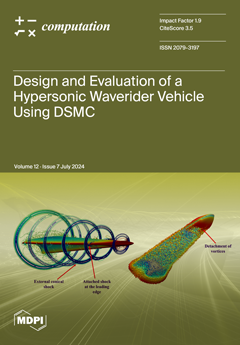The phenomenon of natural convection is the subject of significant research interest due to its widespread occurrence in both natural and industrial contexts. This study focuses on investigating natural convection phenomena within triangular enclosures, specifically emphasizing a valley-shaped configuration. Our research comprehensively analyses
[...] Read more.
The phenomenon of natural convection is the subject of significant research interest due to its widespread occurrence in both natural and industrial contexts. This study focuses on investigating natural convection phenomena within triangular enclosures, specifically emphasizing a valley-shaped configuration. Our research comprehensively analyses unsteady, non-dimensional time-varying convection resulting from natural fluid flow within a valley-shaped cavity, where the inclined walls serve as hot surfaces and the top wall functions as a cold surface. We explore unsteady natural convection flows in this cavity, utilizing air as the operating fluid, considering a range of Rayleigh numbers from Ra = 10
0 to 10
8. Additionally, various non-dimensional times τ, spanning from 0 to 5000, are examined, with a fixed Prandtl number (Pr = 0.71) and aspect ratio (
A = 0.5). Employing a two-dimensional framework for numerical analysis, our study focuses on identifying unstable flow mechanisms characterized by different non-dimensional times, including symmetric, asymmetric, and unsteady flow patterns. The numerical results reveal that natural convection flows remain steady in the symmetric state for Rayleigh values ranging from 10
0 to 7 × 10
3. Asymmetric flow occurs when the Ra surpasses 7 × 10
3. Under the asymmetric condition, flow arrives in an unsteady stage before stabilizing at the fully formed stage for 7 × 10
3 < Ra < 10
7. This study demonstrates that periodic unsteady flows shift into chaotic situations during the transitional stage before transferring to periodic behavior in the developed stage, but the chaotic flow remains predominant in the unsteady regime with larger Rayleigh numbers. Furthermore, we present an analysis of heat transfer within the cavity, discussing and quantifying its dependence on the Rayleigh number.
Full article





